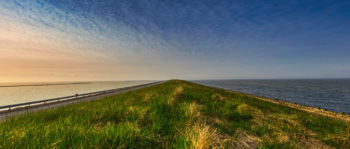Reinforcing the Houtribdijk in the Netherlands Posted by Karoly Molina on Jul 29, 2020 in Culture
One of the many wonders of the Netherlands is the intricate system of dikes that protect the country from flooding. The dikes or dijken have also worked as a way to to create more space in this relatively small country. In this post, I want to talk about one particular dike, the Houtribdijk, and the recently concluded reinforcement project.
IJsselmeer
The IJsselmeer is a lake or meer in the north west of the Netherlands sandwiched between the provinces of North Holland and Flevoland. During the 12th and 13th centuries, the rising sea levels flooded a lot of the land between the lake and the North Sea which turned the lake into a bay called Zuiderzee (south sea). Over the years, there were several attempts to create dikes to protect those living inland, however, it wasn’t until the 1930s that the Zuiderzee was finally closed off and turned into what we now know as the IJsselmeer or the IJssel lake. In short: the IJsselmeer is a lake turned sea turned lake again!
In 1975, the Dutch built a dike called Houtribdijk connecting Enkhuizen and Lelystad which split the IJselmeer and created the body of water known as Markerwaard. The idea was to turn the Markerwaard into a polder, or an artificially created and protected body of land, but the project was abandoned due to a lack of support.
Houtribdijk
The Houtribdijk has been protecting the surrounding land areas for many years now. Because it no longer met the safety norms or veiligheidsnorm, the Rijkswaterstaat responsible for public works and water management, set up a reinforcement or versterking project that spanned 3 years and was recently concluded on time and within budget.
There were four main points to address in the reinforcement. First, the area closest to Enkhuizen was reinforced using sand from the area making it more affordable and sustainable or duurzaam. This is the first time this type of reinforcement was done on non-tidal inland water, and will be closely monitored by Rijkswaterstaat and the Delft University of Technology. Second, a nature reserve called Trintelzand was created providing a natural habitat for aquatic animals, insects, and a nursery for fish strengthening the ecosystem and improving water quality. Third, the area between Trintelhaven and Lelystad was reinforced with quarry stones or breuksteen. Last but not least, there is now a sandy beach in Lelystad for kite and wind surfers (both very popular at beaches here). You can see a short video about the reinforcement below.
Working together
The reinforcement project was done in collaboration with many people and organisations. Cyclists, fishing enthusiasts, and environmental organisations were invited to contribute their ideas and wishes to make the space safe, useful and beautiful. The video below is a mini documentary of the project. I have included a list of useful words to help you with comprehension.
prachtig- magnificent
maatschappelijke organisatie- civil society organisation
belangenafweging- balance of interests
hinder- nuisance
smullen- feast
promovenda- PhD student
voorspellen- predict
trots- proud
vakgebied- discipline, industry
opgeleverd- delivered
Have you ever visited any of the dykes in the Netherlands? Do you have similar infrastructure projects where you live?

Build vocabulary, practice pronunciation, and more with Transparent Language Online. Available anytime, anywhere, on any device.




